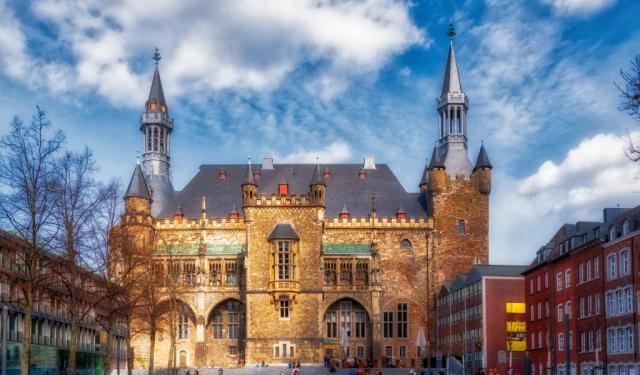
Ponttor Gate, Aachen
The Ponttor (known in the 17th and 18th centuries as the Brückenpforte or Brückenthor) is one of the two remaining gates of the original medieval wall of Aachen (the other being the Marschiertor), and as such is a prominent landmark in the city. The westernmost of the north-facing gates, it was built in 1320, designed for defense purposes, and was originally manned by soldiers and militia throughout Aachen's Free Imperial City era.
The name Ponttor is assumed to be derived from the Latin word "pons", which means bridge. Although indeed, Aachen has several rivers and streams passing through, none of them is found nearby. Still, before the gate appeared, the area itself had already carried this appellation, so the gate must have been named after the neighborhood itself. The latter was named after a bridge that existed in Roman times on what is now known as the Annuntiaten stream. Beyond this area lay extensive swamps, and to exit the settlement, one would have to cross the bridge.
The Ponttor is a right-angled, three-storey gateway with two small towers and the main portal in between. In the main entrance, there is a Portcullis as well as a machicolation, through which things could be dropped onto the invading enemy. A bridge passage with crenelations spanned a moat and was strengthened in the foregate with two reinforced towers (barbicans). The building material was Devonian sandstone, with the framing made of light bluestone.
At the top of the main gate’s arch is the statue of the Virgin, protector of the city.
Today, the Ponttor is used by German Youth and Scout groups belonging to the German Scout Club (1945) and the German Scout Association of Saint George.
The name Ponttor is assumed to be derived from the Latin word "pons", which means bridge. Although indeed, Aachen has several rivers and streams passing through, none of them is found nearby. Still, before the gate appeared, the area itself had already carried this appellation, so the gate must have been named after the neighborhood itself. The latter was named after a bridge that existed in Roman times on what is now known as the Annuntiaten stream. Beyond this area lay extensive swamps, and to exit the settlement, one would have to cross the bridge.
The Ponttor is a right-angled, three-storey gateway with two small towers and the main portal in between. In the main entrance, there is a Portcullis as well as a machicolation, through which things could be dropped onto the invading enemy. A bridge passage with crenelations spanned a moat and was strengthened in the foregate with two reinforced towers (barbicans). The building material was Devonian sandstone, with the framing made of light bluestone.
At the top of the main gate’s arch is the statue of the Virgin, protector of the city.
Today, the Ponttor is used by German Youth and Scout groups belonging to the German Scout Club (1945) and the German Scout Association of Saint George.
Sight description based on Wikipedia.
Want to visit this sight? Check out these Self-Guided Walking Tours in Aachen. Alternatively, you can download the mobile app "GPSmyCity: Walks in 1K+ Cities" from Apple App Store or Google Play Store. The app turns your mobile device to a personal tour guide and it works offline, so no data plan is needed when traveling abroad.
Ponttor Gate on Map
Sight Name: Ponttor Gate
Sight Location: Aachen, Germany (See walking tours in Aachen)
Sight Type: Attraction/Landmark
Guide(s) Containing This Sight:
Sight Location: Aachen, Germany (See walking tours in Aachen)
Sight Type: Attraction/Landmark
Guide(s) Containing This Sight:
Walking Tours in Aachen, Germany
Create Your Own Walk in Aachen
Creating your own self-guided walk in Aachen is easy and fun. Choose the city attractions that you want to see and a walk route map will be created just for you. You can even set your hotel as the start point of the walk.
Aachen's Historical Buildings Tour
Evolved from an ancient Roman settlement, Aachen is one of the oldest and most historic cities in Germany. At one time it served as the capital of Holy Roman Empire. Today's Aachen is just a small city yet with a very rich history and stunning architecture. Despite being heavily damaged during World War II, some of its historical buildings have survived to our days courtesy of the strenuous... view more
Tour Duration: 1 Hour(s)
Travel Distance: 1.7 Km or 1.1 Miles
Tour Duration: 1 Hour(s)
Travel Distance: 1.7 Km or 1.1 Miles
Aachen Introduction Walking Tour
Welcome to Aachen, a city with roots stretching back to Neolithic times. For thousands of years, people have been drawn here by its mineral springs. Archaeologists have uncovered evidence of settlements dating back to the Bronze and Iron Ages. In those ancient days, the Celts made their home here, likely to worship Grannus, the god of light and healing.
By the second century, the Romans had... view more
Tour Duration: 1 Hour(s)
Travel Distance: 1.4 Km or 0.9 Miles
By the second century, the Romans had... view more
Tour Duration: 1 Hour(s)
Travel Distance: 1.4 Km or 0.9 Miles


